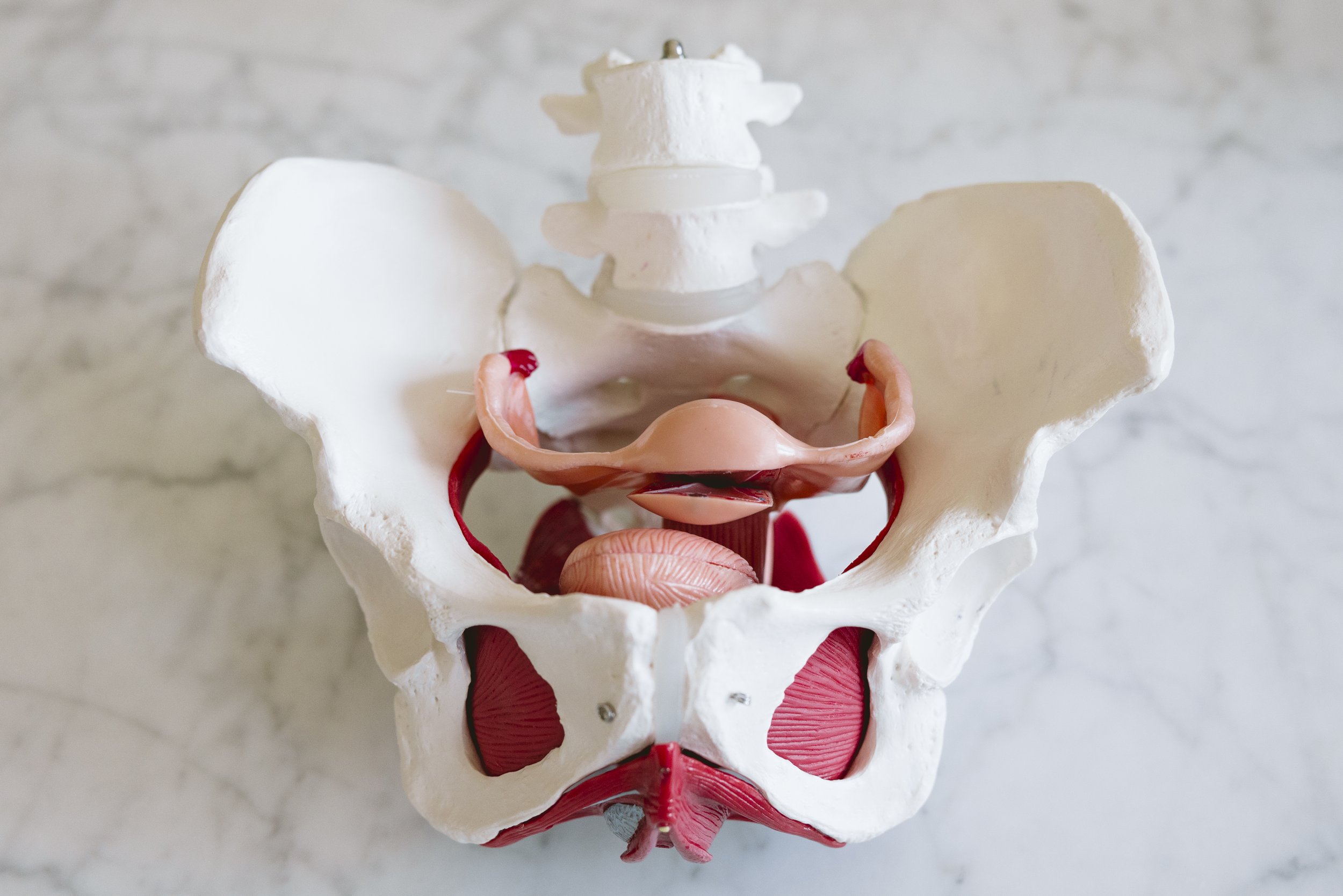
Providing personalized In-home Pelvic Floor Therapy to the pre and postnatal community in Brooklyn, NY
Welcome to the first step in your journey towards optimal pelvic health! My name is Blair Mauri, MS, OTR/L, and I am here to provide you with expert guidance, customized care, and resources that aim to improve the health of your pelvic floor, deepen your understanding of your body's own innate healing powers, and help you get back to fully participating in the most meaningful areas of your life. I conveniently provide all of my services in the comfort of your own home, the place where you feel most comfortable and are most able to connect to yourself. Whether you're currently expecting or a parent on the path to postpartum recovery (once postpartum, always postpartum, it's never too late!), my range of services is tailored to your specific needs. Let's embark on this empowering journey together, I can't wait to meet you!






Frequently Asked Questions
-
The pelvic floor is a group of muscles, ligaments, and connective tissues that form a supportive “hammock” at the base of your pelvis. While it may be easy to overlook, this area plays a powerful role in everyday life, supporting bladder and bowel control, sexual function, core stability, and even breathing and posture. When the pelvic floor is strong and well-coordinated, it works seamlessly with the rest of your body. But when it becomes weak, overly tight, or uncoordinated, it can lead to symptoms like incontinence, pelvic pain, a sense of heaviness, or discomfort during intimacy.
Pelvic Floor Therapy’s Role In Restoring Comfort
Pelvic floor therapy is a specialized, evidence-based approach designed to help restore balance and function to these crucial muscles. Rather than focusing solely on movement restoration, as traditional physical therapy often does, pelvic floor therapy—especially when guided by an occupational therapist like Blair Mauri—takes a holistic approach. This includes addressing emotional, mental, and lifestyle factors that contribute to pelvic health challenges.
Occupational Therapists vs. Physical Therapists
While both occupational therapists (OTs) and physical therapists (PTs) can provide pelvic floor therapy, their approaches and focus areas are different. Physical therapists traditionally emphasize restoring physical movement, strength, and biomechanics. In pelvic floor therapy, PTs often concentrate on muscle function, alignment, and targeted exercises to improve mobility and reduce pain.
An OT specializing in pelvic floor therapy, on the other hand, offers comprehensive care that extends beyond just physical symptoms. With a focus on the whole person, this approach integrates education, mindfulness, emotional support, and body awareness alongside targeted exercises and hands-on techniques. The goal is not only to improve muscle function but also to empower you to understand your body, rebuild confidence, and reconnect with daily activities that bring you joy.
Pelvic Floor Therapy With Blair Mauri, MS, OTR/L
At Blair Mauri Pelvic Health, this holistic philosophy is at the heart of every session. Blair, a licensed occupational therapist, meets you exactly where you are. She listens carefully, never rushes you, and always explains the “why” behind each recommendation so you feel informed and supported throughout your healing journey. Sessions are thoughtfully tailored to your symptoms, goals, and lifestyle, helping you feel seen and truly cared for right in the comfort of your own home. However, please note that she primarily serves women that live in Brooklyn Heights, Park Slope, Cobble Hill, Tribeca, or Dumbo.
-
As you move through life’s milestones, your body will undergo many changes—some expected and others more surprising or difficult to talk about. Pelvic floor challenges are incredibly common among women of all ages and backgrounds (not just those who are pregnant or postpartum) and deserve open discussion. Recognizing these issues is a powerful first step toward healing and empowerment.
Urinary Incontinence: Urinary incontinence is one of the most common pelvic floor concerns. It can show up as small leaks or a strong, urgent need to go, especially when laughing, coughing, or exercising. Factors like hormonal changes, aging, high-impact exercise, and previous surgeries can all contribute to this symptom.
Pelvic Organ Prolapse: A sensation of “heaviness” or the feeling that something is “falling out” in the pelvic area may indicate pelvic organ prolapse. This happens when the muscles and connective tissues supporting the pelvic organs weaken or become overstretched over time.
Pelvic Pain: Aching, burning, or sharp pain in the pelvic region can interfere with daily activities, movement, or intimacy. This pain may be related to muscle tension, nerve irritation, scar tissue, or other structural changes in the pelvis.
Painful Intercourse (Dyspareunia): Pain or discomfort during intimacy is a common concern that can affect people at many stages of life. It may be caused by muscle tightness, hormonal shifts, past trauma, or other pelvic floor dysfunctions.
Constipation And Bowel Dysfunction: The pelvic floor muscles help support proper bowel function. When these muscles are weak, overly tight, or not coordinating properly, issues like constipation or incomplete emptying can develop.
According to the National Institute for Health and Care Excellence (NICE), pelvic floor dysfunction is a complex, multi-factorial process, and associated symptoms can include any of the above. Evidence reviewed by NICE emphasizes the importance of addressing these issues through individualized, evidence-based care to improve overall quality of life. That’s why acknowledging these challenges isn’t a sign of weakness; it’s a crucial act of care and self-awareness. Whether these symptoms arise after childbirth, from lifestyle factors, or simply as part of aging, they deserve compassionate attention and support.
-
Your first pelvic floor therapy session is about creating a safe, supportive space where you feel heard and respected. At Blair Mauri Pelvic Health, your story is at the heart of the process, and every detail matters.
A Comprehensive Conversation
Blair starts by reviewing your intake form in detail (and thank you in advance for taking the time to complete it!). This form is an invitation for you to share your history, symptoms, daily routines, and goals. Don’t worry too much about providing every detail; you’ll have ample time to discuss what inspired you to contact Blair and what you hope to achieve through pelvic floor therapy. Blair will listen attentively the whole time without making you feel rushed or overlooked.
External And Internal Assessments (If You Choose)
If you consent to an external and/or internal pelvic exam, Blair will thoroughly review each option so you feel fully informed about what to expect.
External Exam: This involves gentle observation of the perineal area and assessment of movement patterns. Blair may also palpate bony landmarks, the vulva, and related structures to check for sensation, tissue health, and functional patterns.
Internal Exam: Using one gloved, lubricated finger, Blair will assess the strength, coordination, and overall integrity of your pelvic floor muscles. You may be asked to kegel a number of times, and this portion of the exam typically lasts 3-5 minutes. If you have symptoms suggestive of pelvic organ prolapse, this can also be evaluated at your request. Internal muscle tension, which is often the source of symptoms, can also be treated during this portion of the exam.
Participating in either or both exams is completely your choice. Blair is always happy to answer questions and help you weigh the pros and cons of each during your appointment. Remember, your comfort and consent are always prioritized, so you can pause or stop at any time. Blair will also check in with you throughout the exam to make sure you feel well enough to proceed.
Additional Evaluations Tailored To You
Depending on your symptoms and goals, your evaluation may include assessments of your breathing patterns and posture, pelvic alignment and core function, and uterine mobility if relevant. Blair might also discuss your birth preferences (if applicable), review your movement patterns and daily ergonomics, and evaluate any scars, including cesarean or perineal scars. She will also examine your bowel and bladder habits, check for diastasis recti (abdominal separation), discuss pain levels, and include a mental health and emotional well-being check-in. The initial evaluation typically lasts about 1 to 1.5 hours, allowing for a thorough, unrushed experience that honors your individual needs and comfort.
You’re always encouraged to bring up any additional concerns or questions at any point. If there’s something outside of Blair’s scope that you’re curious about, she will do her best to either research an answer and get back to you or refer you to a trusted practitioner.
-
A common question when considering pelvic floor therapy in Brooklyn is, “How long will this take?” The truth is, there’s no universal timeline. Your healing journey depends on your unique body, health history, and personal goals.
Typical Progress And Session Frequency
Most people begin to notice meaningful progress within 12 visits with an insurance-based therapist. However, many of Blair’s clients achieve comparable or even better results with fewer visits thanks to her personalized, in-depth approach. With her out-of-network care model, sessions are usually an hour long and focus on treating the whole person, not just isolated symptoms. Of course, everyone’s progress looks different, but a vast majority of Blair’s clients experience noticeable improvement within 4-6 sessions, sometimes fewer, sometimes This model allows for deeper assessment, thorough education, and dedicated time to develop strategies tailored to your daily life. While a standard insurance-based plan might involve 30–45 minute visits for 12 or more sessions, Blair’s approach often results in fewer visits, ultimately saving you time and supporting faster, more sustainable progress.
A Gentle, Individualized Pace
Your healing isn’t meant to be rushed. Pelvic floor therapy is about rebuilding strength, coordination, and trust in your body at a pace that feels safe and empowering. If every other week or monthly sessions work better for your schedule and budget, Blair also provides support between visits via email or quick check-ins to ensure you stay on track.
Healing Happens On Your Terms
The length of your therapy is never a measure of your effort or worth. Healing is deeply personal, and lasting change happens when you give your body the time and care it deserves.
-
Pelvic floor therapy is an investment in your long-term comfort, function, and confidence. Rather than offering quick, rushed visits that only scratch the surface, Blair Mauri Pelvic Health focuses on comprehensive, personalized care designed to make a lasting impact in the comfort of your own home.
Flexible, Cost-Conscious Packages
To make ongoing support more accessible, Blair offers thoughtfully designed discounted packages in her online store. These bundles ensure you receive thorough, unrushed sessions that maximize progress while reducing the total number of visits needed. Here are her two package options:
Pelvic Floor Package 1 ($1,161): This is ideal for those ready to commit to a focused treatment plan. It includes six sessions, each typically 60–90 minutes long, allowing for deep, individualized work.
Pelvic Floor Package 2 ($1,236.60): This package is perfect for new clients starting their journey. It includes a comprehensive initial evaluation plus five follow-up sessions, giving you a strong foundation and continued support as you move forward.
A Personalized, Value-Driven Approach
By choosing an out-of-network, longer-session model, most clients find they can achieve meaningful progress in fewer visits compared to traditional clinic-based care. Blair’s approach prioritizes quality time, whole-person healing, and respect for your individual pace, offering value while honoring your time and resources.
-
If you have a pelvic floor, you can experience symptoms, and you can benefit from therapy. Care is never limited to those who are pregnant or postpartum; anyone experiencing pelvic floor dysfunction deserves compassionate, tailored support. If you’re dealing with symptoms like bladder leaks, pelvic pain, constipation, painful intercourse, or a lingering sense that things “just don’t feel right” in your core, you should feel empowered to speak up. These challenges can arise at any stage of life, regardless of age or whether you’ve given birth.
The Deeper Connections
Sometimes, it isn’t obvious where your discomfort is coming from. You might notice back or hip pain, unexpected pressure, or tension that won’t ease despite stretching or strengthening. That’s because the pelvic floor is deeply connected to everyday movement, posture, and even emotional health. Life transitions such as pregnancy, postpartum, menopause, increased stress, and certain types of athletic training can all affect these important muscles.
Choosing Empowerment And Understanding
Choosing pelvic floor therapy is an opportunity to listen to your body and prioritize your well-being. Working with a knowledgeable, compassionate therapist like Blair helps you better understand your anatomy, uncover the root causes of your symptoms, and find personalized strategies for meaningful, lasting relief. Even if you feel nervous or unsure, pelvic floor therapy is designed to empower you, educate you, and help rebuild trust in your body. You deserve care that meets you exactly where you are—whether you’re preparing for parenthood, moving through menopause, or simply seeking a healthier, more comfortable life.
If you're ready to take the next step, browse Blair's full range of services or book a free discovery call today.
